
Phobaeticus serratipes is a species of stick insect that at one time was the longest known insect, with one female specimen recorded as being 55.5 cm (21.9 in) in total length. This measurement includes the legs fully extended front and rear, and the actual length of the body alone is considerably shorter. This insect is endemic to Peninsular Malaysia, Singapore and Sumatra. It is a popular species among those who raise insects.
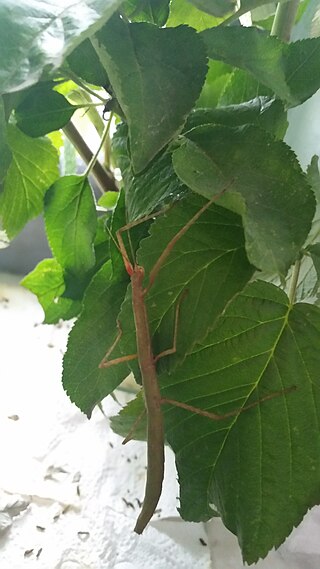
Carausius morosus is a species of Phasmatodea (phasmid) often kept as pets by schools and individuals. Culture stocks originate from a collection from Tamil Nadu, India. Like the majority of the Phasmatodea, C. morosus are nocturnal. Culture stocks are parthenogenetic females that can reproduce without mating. There are no reports of males, although in captivity, gynandromorphs are sometimes reared.

Heteropteryx is a monotypic genus of stick insects containing Heteropteryx dilatata as the only described species. and gives its name to the family of the Heteropterygidae. Their only species may be known as jungle nymph, Malaysian stick insect, Malaysian wood nymph, Malayan jungle nymph, or Malayan wood nymph and because of their size it is commonly kept in zoological institutions and private terrariums of insect lovers. It originates from the Malay Archipelago and is nocturnal.
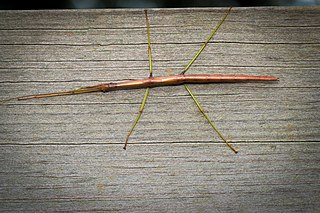
The common walkingstick or northern walkingstick is a species of phasmid or stick insect found across North America. The average length of this species is 75mm (3 in) for males and 95mm (3.7 in) for females.
Hermarchus is a genus of very large stick insects within the order Phasmatodea and the tribe of Stephanacridini. Known species occur in New Guinea, Fiji, Australia, Philippines and New Caledonia.

Eurycnema goliath, commonly known as the goliath stick insect, or the regal stick insect, is a large species of stick insect in the family Phasmatidae, endemic to Australia and considered one of the largest species of stick insects in the country. The species has the Phasmid Study Group number PSG14.
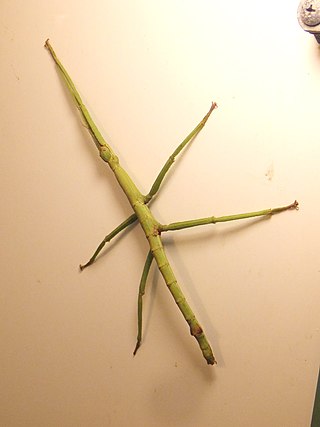
Pharnacia is a tropical Asian genus of stick insects in the family Phasmatidae and subfamily Clitumninae. Some species formerly placed in this genus have been reassigned to Phobaeticus.
Asceles is a genus of stick insects in the tribe Necrosciini. Some of the species of Asceles have a distribution in Malaysia and Singapore.
Phobaeticus hypharpax, is a species of phasmid or stick insect of the genus Phobaeticus. It is found in Sri Lanka and Southeast India. It is closely related to the Sri Lankan species Phobaeticus lobulatus and the Southeast Indian Phobaeticus sinetyi. It is characteristic for the sparse but very broad and prominent serrations of the anterodorsal carina of the front femora and unarmed medioventral carina of the middle and back femora. It is also distinctive for its particularly long abdomen.

Datamini is the only tribe within the subfamily of the Dataminae from the order of the Phasmatodea. The representatives of this subfamily are on average not as large as those of the other two subfamilies belonging to the family of Heteropterygidae.

Heteropterygini is the only tribe within the subfamily of the Heteropteryginae. With 19 representatives described, this subfamily includes the fewest species of the three subfamilies, but includes the largest and most striking species of the family.
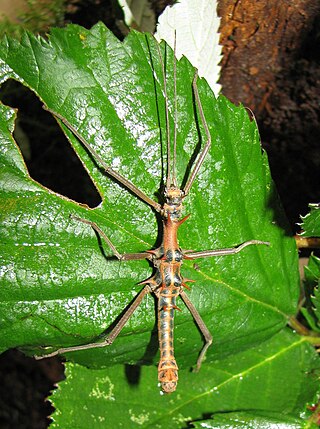
Epidares nolimetangere, the touch-me-not stick insect, is an insect species from the order of the Phasmatodea and the only representative of the genus Epidares. The species name nolimetangere comes from Latin and means "don't touch me". It refers to the prickly appearance of the animals.

Aretaon asperrimus is a species of insect in the Aretaon genus of the Phasmatodea order. The sometimes used common name thorny stick insect is a bit misleading, since the species does not correspond to the typical stick-like habitus and many other species are thorny as well.

Trachyaretaon carmelae is a species of stick insects. It is one of the largest in the subfamily Obriminae.
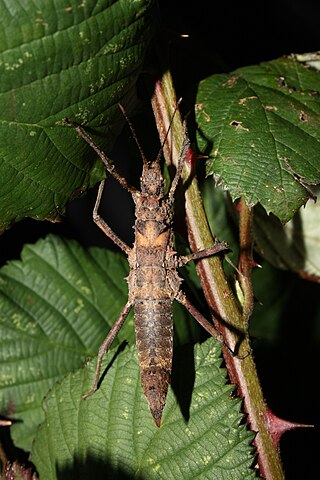
Hoploclonia cuspidata is a stick insect species native to the north of Borneo and is also called Brunei Hoploclonia stick insect.
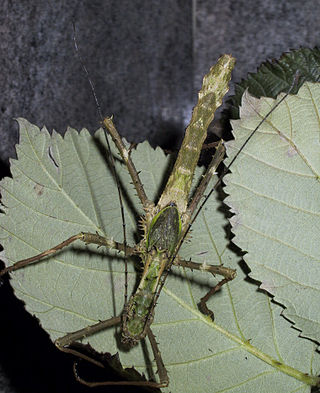
Haaniella erringtoniae is a stick insect species. It is a typical representative of the subfamily Heteropteryginae. The occasionally used common name Errington's Haaniella refers to the species name.
Tirachoidea biceps is a species of stick insect in the order Phasmatodea. It is endemic to Java, Peninsula Malaysia, and Sumatra. Females of this species average 195 mm (7.7 in) and are apterous. Although males are fully winged, their flight capability is poor. Tirachoidea biceps was previously known as Pharnacia but is distinguishable by two bumps on their hind head.
Tirachoidea westwoodii is a species of stick insect in the order Phasmatodea. It is endemic to India, Myanmar, Thailand and Vietnam. The eggs of the stick insect are spheric, ca. 5 mm in length and have a three-lobed micropylar plate. The chorion of the eggs are hard to cut and consist of the three layers mineralized with calcium carbonate and calcium oxalate.

Heterocopus is a monotypic stick insect genus, containing Heterocopus leprosus as the only valid species.













